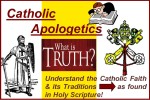Wednesday of the 1st Week of Advent
 Today’s Content:
Today’s Content:
- Dan’s Deliberations, Discoveries, & Declarations
- Today in Catholic History
- Catholic Apologetics
- A Franciscan’s Saint of the Day
- Reflection on article of the OFS Rule
ТТТ
Dan’s Deliberations, Discoveries, & Declarations:
Last Sunday and today, I am sharing information on two objects used by all people in a secular way, the song “The Twelve Days of Christmas” and the “Candy Cane”. However, these items started out as ways to catechize Catholics during times of suppression from governments of the day.
Т
The Candy Cane
(Adapted by Charles Kirkpatrick)
The candy cane is a long-time Christmas tradition. Everywhere we look we see them. Did you know they are based on Holy Scripture? Here are two verses from both the Old and New Testaments:
“The LORD is my shepherd; I shall not want” (Psalm 23:1).
“He himself bore our sins in his body on the tree, so that we might die to sins and live for righteousness; by His stripes you have been healed” (1 Peter 2:24).
The candy cane is a long-time Christmas tradition. Everywhere we look we see them. They are used as decorations on Christmas trees and, of course, they are one of the most popular of all Christmas treats. I have heard several stories about the history and meaning of the candy cane. I don’t know if they are
true, but I do think that the candy cane can teach us a few things about the true meaning of Christmas.
First of all, if you look at the candy cane like this it looks like the letter J. Jesus starts with the letter J, so that should remind us of Jesus and help us to remember that Christmas is Jesus’ birthday.
If you look at the candy cane this way, it looks like a shepherd’s crook. The shepherd used
his crook to keep the sheep from wandering away from the flock and getting lost or eaten by a wild animal. The Bible says, “The Lord is my shepherd.” The candy cane should remind us that Jesus is our shepherd and He will keep us from wandering away and getting lost or hurt.
The candy cane is mostly white, a symbol of purity. That should remind us that Jesus was the spotless Lamb of God and that because He came to be the sacrifice for our sin, we can become as white as snow.
As you know, the candy cane has three red stripes. The Bible tells us that before He was crucified, Jesus was beaten with a whip which made blood-red stripes across his back. The Bible says that we are healed by those stripes. The stripes on the candy cane should remind us that Jesus suffered and died, so that we can have everlasting life.
To many people, the candy cane is a meaningless decoration seen at Christmas time or just a piece of candy to be eaten and enjoyed. I hope that this year, every time you see a candy cane, you will be reminded of the true meaning of Christmas.
http://www.sermons4kids.com/candycane.html
ТТТ
 Today in Catholic History:
Today in Catholic History:
† 663 – Fourth Council of Toledo takes place.
† 749 – Death of Saint John of Damascus, theologian
† 1301 – Pope Boniface VIII’s degree Ausculta fili (only nominee)
† 1443 – Birth of Pope Julius II, Albisola, Republic of Genoa, Pope (1503-13), patron of Michelangelo, Bramante, Raphael, (d. 1513)
† 1484 – Pope Innocent VIII issues the Summis desiderantes, a papal bull that deputizes Heinrich Kramer and James Sprenger as inquisitors to root out alleged witchcraft in Germany and leads to one of the severest witch hunts in European history.
† 1492 – Christopher Columbus (A Secular Franciscan) becomes the first European to set foot on the island of Hispaniola.
† 1590 – Niccolo Sfondrati chosen Pope Gregory XIV
† 2008 – Death of Patriarch Alexy II of Russia, head of the Russian Orthodox Church (b. 1929)
(From the “On This Day” Blog Site
otday.wordpress.com &/OR
“Today in Catholic History”
http://www.historyorb.com)
ТТТ
 Catholic Apologetics:
Catholic Apologetics:
My reason and purpose for this section on my blog is to provide “scriptural confirmation” for our beliefs and doctrines, not to cause dissention or opposition with my fellow believers in Jesus Christ, yet not in union with the Roman Catholic Church. Whether God speaks to us through the “Bible”, or through “Tradition”, it is the Holy Spirit who inspires the “Word” from which all authentic tradition flows.
Tradition can be separated into two aspects: oral and behavioral. Oral tradition includes written forms. After all, it ALL started with oral tradition. Behavioral tradition includes Baptism, Eucharist or Lord’s Supper, Laying on of hands for healing, Intercessory prayer, and Ordination.
All Scriptural verses are taken from both the Revised Standard Version: Catholic Edition of the Holy Bible and the King James Version of the Holy Bible.
Christ’s Divinity, Part 1:
“For to us a child is born, to us a son is given; and the government will be upon his shoulder, and his name will be called ‘Wonderful Counselor, Mighty God, Everlasting Father, Prince of Peace’” (Isaiah. 9:6). RSV
“For unto us a child is born, unto us a son is given: and the government shall be upon his shoulder: and his name shall be called Wonderful, Counsellor, The mighty God, The everlasting Father, The Prince of Peace.” (Isaiah. 9:6). KJV
*
“Simon Peter replied, ‘You are the Christ, the Son of the living God.’ And Jesus answered him, ‘Blessed are you, Simon Bar-Jona! For flesh and blood has not revealed this to you, but my Father who is in heaven’” (Matthew 16:16-17). RSV
“Simon Peter answered and said, Thou art the Christ, the Son of the living God. And Jesus answered and said unto him, Blessed art thou, Simon Barjona: for flesh and blood hath not revealed it unto thee, but my Father which is in heaven.” (Matthew 16:16-17). KJV
*
“In the beginning was the Word, and the Word was with God, and the Word was God” (John 1:1). RSV
“In the beginning was the Word, and the Word was with God, and the Word was God”. (John 1:1). KJV
ТТТ
 A Franciscan’s Saint of the Day: St. Sabas (b. 439)
A Franciscan’s Saint of the Day: St. Sabas (b. 439)
Born in Cappadocia (modern-day Turkey), Sabas is one of the most highly regarded patriarchs among the monks of Palestine and is considered one of the founders of Eastern monasticism.
After an unhappy childhood in which he was abused and ran away several times, Sabas finally sought refuge in a monastery. While family members tried to persuade him to return home, the young boy felt drawn to monastic life. Although the youngest monk in the house, he excelled in virtue.
At age 18 he traveled to Jerusalem, seeking to learn more about living in solitude. Soon he asked to be accepted as a disciple of a well-known local solitary, though initially he was regarded as too young to live completely as a hermit. Initially, Sabas lived in a monastery, where he worked during the day and spent much of the night in prayer. At the age of 30 he was given permission to spend five days each week in a nearby remote cave, engaging in prayer and manual labor in the form of weaving baskets. Following the death of his mentor, St. Euthymius, Sabas moved farther into the desert near Jericho. There he lived for several years in a cave near the brook Cedron. A rope was his means of access. Wild herbs among the rocks were his food. Occasionally men brought him other food and items, while he had to go a distance for his water.
Some of these men came to him desiring to join him in his solitude. At first he refused. But not long after relenting, his followers swelled to more than 150, all of them living in individual huts grouped around a church, called a laura.
The bishop persuaded a reluctant Sabas, then in his early 50s, to prepare for the priesthood so that he could better serve his monastic community in leadership. While functioning as abbot among a large community of monks, he felt ever called to live the life of a hermit. Throughout each year —consistently in Lent—he left his monks for long periods of time, often to their distress. A group of 60 men left the monastery, settling at a nearby ruined facility. When Sabas learned of the difficulties they were facing, he generously gave them supplies and assisted in the repair of their church.
Over the years Sabas traveled throughout Palestine, preaching the true faith and successfully bringing back many to the Church. At the age of 91, in response to a plea from the Patriarch of Jerusalem, Sabas undertook a journey to Constantinople in conjunction with the Samaritan revolt and its violent repression. He fell ill and, soon after his return, died at the monastery at Mar Saba. Today the monastery is still inhabited by monks of the Eastern Orthodox Church, and St. Sabas is regarded as one of the most noteworthy figures of early monasticism.
Comment:
Few of us share Sabas’s yearning for a cave in the desert, but most of us sometimes resent the demands others place on our time. Sabas understands that. When at last he gained the solitude for which he yearned, a community immediately began to gather around him and he was forced into a leadership role. He stands as a model of patient generosity for anyone whose time and energy are required by others—that is, for all of us.
Saint of the Day: Lives, Lessons and Feast
By Leonard Foley, O.F.M.;
revised by Pat McCloskey, O.F.M.
(From http://www.americancatholic.org website)
ТТТ
 Secular Franciscan Order (OFS) Rule Article #’s 05 & 06 of 26:
Secular Franciscan Order (OFS) Rule Article #’s 05 & 06 of 26:
05. Secular Franciscans, therefore, should seek to encounter the living and active person of Christ in their brothers and sisters, in Sacred Scripture, in the Church, and in liturgical activity. The faith of St. Francis, who often said, “I see nothing bodily of the Most High Son of God in this world except His most holy body and blood,” should be the inspiration and pattern of their Eucharistic life.
Т
06. They have been made living members of the Church by being buried and raised with Christ in baptism; they have been united more intimately with the Church by profession. Therefore, they should go forth as witnesses and instruments of her mission among all people, proclaiming Christ by their life and words.
Called like Saint Francis to rebuild the Church and inspired by his example, let them devote themselves energetically to living in full communion with the pope, bishops, and priests, fostering an open and trusting dialog of apostolic effectiveness and creativity.
ТТТ